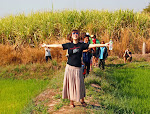 Here in Khon Kaen, Thailand working as a member of a group and visiting villages every few weeks, the term solidarity has come up a few times. It seems the more time passes, the more frequently the term is used. The question though is what is solidarity in terms of these issues? What does it mean in the villages?
Here in Khon Kaen, Thailand working as a member of a group and visiting villages every few weeks, the term solidarity has come up a few times. It seems the more time passes, the more frequently the term is used. The question though is what is solidarity in terms of these issues? What does it mean in the villages?On a journey to discover what solidarity really means, one telling village was that of Ban Huay Top Nai Noi. Not only does this village share passion and drive, but they have a plan. Made up of villagers from two different surrounding villages, this protest village was formed to protest a dam project upstream. These villagers’ homes were not going to be flooded, but their farms, their livelihoods, were. In 1995 the protest village formed in the flood zone of the proposed dam project. Paw Sampone said, “We moved to the flood zone because if they want to build the dam, build the dam. But, if you retain any water you will be killing people.” The power of their mission is not just for themselves however, it is for the land and the people around them.
In 2011 the Environmental Impact Assessment (EIA) was finished for the dam project. The people decided though that they would not move until the EIA and SIA (social impact assessment) was done for surrounding villages and dam projects. They are part of a greater network, working towards one goal—protecting their way of life. For communities we visited on unit 4, potential or previous dam sites, the river is more than a source of water. The flooding created or exacerbated by dams is not just detrimental to the crops in the farm land or the homes in the area, but it completely destroys livelihoods.
For example, in communities affected by the Rasi Salai dam, the end of the rainy season has led to absolutely no source of income for the people. The wetlands, their original source of food and crops, are flooded. They cannot gather crops that have been sustaining their families for hundreds of years. Their farmlands are also flooded because of the dam reservoir, to the point where the can only get around some parts by boat. Many cannot even walk to their farms to see how much damage has been done. The final aspect of these villagers’ income come from handicrafts made and sold at the local learning center. The center is up to the roof with water because the land the people were given for the project is located on the banks of the reservoir. The supplies to make most of the crafts come from their fields as well. So without farm land just a few weeks before harvest, no crafts and no place to sell them, the dam has led to no financial stability or security for the people of Rasi Salai. Their homes may not be flooded, but they continue to band together because without the other community members, some families could easily go hungry.
This community serves as a mentor for that of Ban Huay Top Nai Noi. They have provided guidance, comfort, and support during the hard times. They inspire the people of Ban Huay Top Nai Noi, and encourage their fight. Even through the violence that has occurred, the people of the protest village stayed in their new location. Their presence is a fight, it is a message. “We do this for the land. Land cannot regenerate but people are born everyday.” Their strength comes from each other. “Where ever we go, we go together. We share everything, not just knowledge.” These words of the community members are what enable the movement they are a part of. They have a cause and support and the strength of their community is what true solidarity looks like. They stand, fall, live and fight together.
Julie Yermack
University of Richmond







